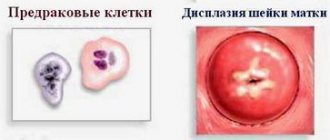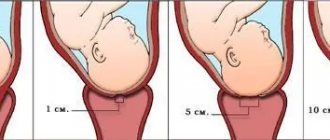What is dysplasia
Dysplasia is a pathology that concerns cellular changes in epithelial tissue.
The cervical mucosa has three layers, each of which is represented by a specific type of cell. With dysplasia, the boundaries of these layers are erased, since changes occurring in the cells lead to atypia.
That is, healthy cells are replaced by altered ones, which have an irregular shape and may contain more than one nucleus. Such cells do not perform the necessary functions, and, in addition, in the presence of certain provoking factors, they can transform into malignant ones .
IMPORTANT! Cervical dysplasia is a serious and quite dangerous disease, which is grade 3 non-invasive cancer, which differs from an invasive malignant process in the absence of penetration into nearby tissues.
Dysplasia is a benign change, but the disease significantly increases the risk of developing a malignant tumor
Classification
To diagnose cervical neoplasia, the doctor prescribes a cytology smear (Papanicolaou test). Depending on the results obtained, the disease is classified as one of the degrees of development of dysplasia:
- The first degree (mild), in which only the outer layer of epithelial tissue is affected, no more than a third of the thickness. In 55% of cases, the disease recedes after the virus is removed from the female body. When treating grade 1 cervical dysplasia, a wait-and-see approach is often used, prescribing immune-strengthening drugs and periodic diagnostics.
- Second (medium) – changes in the degeneration of the cellular layer are moderate and affect less than two-thirds of the thickness of the epithelial layer of the cervix. When treating grade 2 cervical dysplasia with antiviral drugs, a complete cure occurs in 40% of cases.
- Third (severe) degree - initial manifestations of carcinoma occur, all 100% of flat multilayered epithelial tissue is affected, without transition to connective tissue. Stage three is considered a non-invasive form of cancer. Research results indicate the probability of transition of cervical dysplasia to oncology in 10-30% of cases of the disease, depending on individual risk factors. In the case of grade 3 cervical dysplasia, treatment is often surgical.
Causes
Dysplasia in most cases is a consequence of exposure to the papillomavirus virus on the cervical mucosa.
A pathogenic virus can remain on the mucous membrane for a long time and not manifest itself in any way, but when favorable conditions arise, the virus begins to actively multiply and integrate into the structure of healthy cells. In this case, the cells change and become atypical.
Particularly dangerous are viruses of oncogenic strains - 16 and 18, which significantly increase the risk of developing oncology.
Predisposing factors for the development of pathology may be the following:
- early sexual intercourse, early birth or abortion;
- low immunity;
- smoking;
- gynecological diseases in the chronic stage;
- inflammatory and infectious processes in the reproductive organs;
- avitaminosis;
- injuries of a mechanical nature - abortions, difficult or multiple births, surgical interventions in the genital organs;
- frequent change of sexual partners;
- heredity;
- presence of penile cancer in an intimate partner;
- long-term use of oral contraceptives;
- hormonal imbalances and endocrine pathologies.
Degrees of dysplasia
Dysplasia is classified based on the following characteristics:
- Treatment of uterine adenomyosis with folk remedies
- how much changed cells have penetrated into epithelial tissues;
- what changes occurred in the structure of cells;
- morphology of the damage site.
Based on this, dysplasia is divided into three degrees:
- Grade 1 – a weak form of the disease, in which atypical cells affect the lower third of the epithelial layer. The modification of the basal layer is not clearly expressed, but the analyzes show signs of papillomavirus;
- 2nd degree – moderate form. Structural changes become more pronounced, atypia is observed in half of the epithelium, progress of morphological changes in cells is noted;
- 3rd degree – severe form. Lesions of an atypical nature are observed as deeply as possible, structural cellular changes are strongly expressed, pathological cell division can be observed, and the cells themselves have irregular or too large nuclei. The pathology affects only the mucous membrane and does not affect neighboring tissues, muscles, vessels and nerves.
Symptoms of the disease
Self-detection of the disease is extremely difficult due to the lack of a well-defined clinical picture. The disease is most often diagnosed after tests during preventive examinations by a gynecologist. Most often there are no symptoms of the disease. This is why regular gynecological examinations are so important.
Symptoms that indicate the presence of cervical dysplasia:
- The appearance of vaginal discharge in greater quantities than usual with a change in its viscosity, color (usually white) and odor (unpleasant).
- A burning sensation, itching in the inside of the vagina, lower abdomen.
- The occurrence of blood inclusions or discharge after removal of a tampon or sexual contact.
- Unpleasant painful sensations that occur during sexual intercourse.
- Pulling pain in the lower abdomen.
When is conservative treatment possible?
In most cases, dysplasia is treated with medications or surgery. However, if the degree of dysplasia is not critical (1 or 2 without complications), you can try to cope with the disease using traditional methods.
Consultation with a doctor before using folk remedies is mandatory, since only a competent specialist can determine how appropriate such treatment is, and also find out whether the patient has any contraindications to the use of one or another non-traditional method of treatment.
Treatment with traditional methods may well be combined with the use of traditional medications. However, it is worth remembering that if folk and conservative treatment for three months does not lead to positive dynamics, or, moreover, worsens the condition of the mucous membrane, it is necessary to change the treatment tactics and resort to more serious therapy.
There are 3 degrees of cell pathology. The initial (first, mild) stage , as a rule, responds well to treatment, affects only the superficial layers of cells and is a consequence of inflammation. Competent anti-inflammatory treatment is the key to recovery. In this case, the main therapy can be supplemented with folk methods locally or general regimens for taking medications orally.
Moderate dysplasia is a borderline condition. The treatment is more aggressive, but the use of traditional recipes is also acceptable, but only at the discretion and recommendation of a doctor.
- Treatment of tinnitus at home: traditional methods and useful recommendations
Severe dysplasia is the most dangerous. Sometimes it hides the initial stages of cancer. As a rule, surgical treatment methods are used, including radio wave conization of the cervix. Traditional methods can be used to enhance tissue healing after such treatment.
Traditional methods can be effective as an additional treatment to the main one. You shouldn’t count on the fact that such recipes on their own will help get rid of a serious disease. This can waste valuable time, aggravate the pathological process and increase the likelihood of cancer cells appearing.
We recommend reading about why cervical erosion occurs. From the article you will learn about the causes of cervical erosion, why and after what time it can appear again.
Contraindications to the treatment of dysplasia using traditional methods
Even traditional methods should be used only on the recommendation and approval of a doctor. Before starting therapy, you need to undergo a comprehensive examination, primarily to exclude malignant processes. It is not advisable to use traditional methods in the following cases:
- For moderate and severe dysplasia, as well as if cancer cannot be ruled out.
- In case of increased sensitivity of the body to the components used.
- During pregnancy and breastfeeding.
We recommend reading about the causes of cervical erosion after childbirth. From the article you will learn about the types of cervical erosion, symptoms in a young mother, diagnosis and treatment.
And here is more information about the features of treatment of cervical ectopia of the cervix with chronic cervicitis.
Dysplasia is a serious disease that requires careful examination and proper treatment. It is not possible to get rid of pathology only using folk remedies. However, such prescriptions can be used as an addition to the main treatment regimens.
Treatment of cervical dysplasia with herbs
Herbal treatment for cervical dysplasia is not basic therapy and is used only as an additional remedy that supports the protective properties of local immunity of epithelial tissue. However, herbs can be a good help after surgical procedures (cauterization, cryodestruction, conization), but only in the dosage and mode of application recommended by the gynecologist.
Here are some of the most effective and at the same time safe recipes for herbal treatment:
- Pine buds are rich in essential compounds. In turn, they have a powerful antibacterial effect due to the presence of bornyl acetate, pinene, limonene and other ingredients. Raw pine buds need to be finely chopped with a knife. The raw materials (3 tablespoons) are poured with cold water (1 liter) and boiled over very low heat for 3-4 minutes. Cooled to an acceptable room temperature, the decoction can be safely used for washing, irrigating and douching 2 times a day for two weeks. Please note that this recommendation is not universal; in any case, you should consult with your gynecologist.
- An infusion or decoction of twig, which is better known as vitex, is very effective. It is no coincidence that this shrub is called the “sacred” tree of Abraham (Vitexagnus castus). The leaves and fruits of the bush have a hemostatic effect, a property that normalizes the functioning of the hormonal system. Even in ancient times, they were successfully used by Hippocrates in the treatment of female diseases. Cervical dysplasia, of course, is unlikely to disappear after douching with a solution of twig, but as an auxiliary treatment, vitex is worthy of study and use.
- A decoction of burdock root mixed with milk thistle herb. This composition cleanses the blood well, activates blood supply to epithelial tissue and promotes rapid healing of wound surfaces.
Using traditional methods
How to treat dysplasia with folk remedies? Below are the most famous and effective recipes.
Pine needles and buds
One of the effective treatments for dysplasia are pine needles and buds. They contain a lot of vitamins, essential oils and phytoncides.
Thanks to these components, decoctions of pine buds and needles have an antitumor, restorative, and antiseptic effect, so this remedy is widely used for dysplasia.
To prepare a healing decoction from pine needles, you need to pour 3 tablespoons of raw materials collected in February-March, 400 ml of boiling water and place in a water bath for 15 minutes. Then leave it covered for another 2 hours and drink 100 ml per day.
To prepare an elixir from pine buds, you first need to grind them, and then pour a glass of boiling water over a tablespoon, boil for a couple of minutes, and then leave for half an hour. It is recommended to douche with this product once a day for about 3 weeks.
Calendula
Calendula has analgesic, antiseptic and restorative effects. There are two ways to prepare the medicine.
For douching and soaking tampons you will need:
- 2 tablespoons of calendula flowers;
- 1 tablespoon nettle;
- some rose hips;
- a spoonful of yarrow, meadowsweet and licorice;
- a teaspoon of sweet clover.
All ingredients are mixed well. Take 400 ml of boiling water per tablespoon of the mixture. The infusion is left for half an hour under the lid, and then douched three times a day or a tampon soaked in the product is inserted.
An ointment can be prepared from calendula, which is used for tamponation. To do this, you will need to mix the flowers of the plant with sunflower or olive oil. The product must be placed in a dark glass container and left for 10 days. Then the ointment is filtered and used for tamponation. The tampon is kept in place for 3-4 hours.
Application of ASD
The drug ASD was created at the end of the 40s by the Soviet scientist Dorogov.
This product contains:
- phenols;
- carboxylic acids;
- aliphatic amines;
- hydrocarbons;
- sulfahydrides.
When using ASD to treat dysplasia, the following effect can be achieved:
- normalize hormonal levels;
- eliminate inflammation;
- increase local immunity;
- destroy all pathogens in the cervical area;
- restore tissue saturation with useful substances;
- eliminate the adhesive process;
- eliminate pain during sexual intercourse.
To treat dysplasia, the drug ASD can be taken orally and used for douching.
For oral administration, 30 drops of the drug must be dissolved in 100 grams of boiled water. Take twice daily before meals. The course of treatment is 24 days, and you need to take the drug for 5 days, then a 3-day break, and so on.
For douching, ASD (10g) is diluted in a liter of warm boiled water. The procedure is carried out twice a day for 5 days, then a 3-day break. You need to use the product for a month, gradually increasing the proportion to 25 grams of ASD per liter.
ASD can be used both for oral administration and for douching
Taking vitamins
To successfully treat the disease, we must not forget about the role of vitamins in this process.
For dysplasia, vitamins such as:
- folic acid - to normalize cell division and prevent mutation;
- vitamin A – to accelerate regeneration;
- vitamin B1 – to protect against mutations;
- vitamin B2 – to improve blood circulation, enhance immunity and neutralize toxins;
- vitamin B6 – for antitumor effect;
- vitamin B12 – to normalize reproductive function;
- vitamin C – to improve metabolism;
- vitamin E – antioxidant effect;
- beta-carotene – to simulate immunity;
- selenium – to reduce the risk of cancer.
Massage for cervical dysplasia
Used for the treatment of cervical dysplasia and massage. A doctor may prescribe it as a means of improving lymph flow and activating recovery processes. Classic, acupressure or segmental massage will eliminate menstrual irregularities that occur as a result of the disease and relieve a tense emotional state.
Gynecological massage will help with adhesions accompanying third-degree dysplasia. With such a change as ovarian hypofunction, vibration massage is indicated. These treatment methods not only help to defeat the disease in the shortest possible time, but are also a means of preventing dysplasia.
Homeopathy
How to cure cervical dysplasia with homeopathy? Almost all of these drugs are not combined with the treatment of the disease, since there is no component for making the medicine.
However, it may well be used as an additional remedy to enhance local immunity and normalize well-being. The objectives of homeopathy for dysplasia are:
- Normalization of the monthly cycle;
- Establishing normal ovarian function;
- Restoration of the nervous system;
- Treatment in special cases when conventional medications cannot be taken, for example, during pregnancy;
- Strengthening the whole body.
In the treatment of cervical dysplasia, the following homeopathy remedies are used:
- If a woman’s body has the papilloma virus, which most often causes dysplasia, then Papillocan suppositories are used. The main active ingredient is thuja extract, as well as tea tree oil. Using these components, the drug is specifically prescribed to affect the source of inflammation;
- In cases where a woman’s monthly cycle is disrupted due to pathology, the drug Ovarium is used. Its action is aimed at improving hormonal levels, reducing anxiety, improving the functioning of the nervous system;
- There is another homeopathy drug - gynecohel. It is useless for the treatment of dysplasia directly. But when the disease is accompanied by other inflammatory processes, the drug acts specifically on them, making a woman’s life easier.
The dosage of homeopathy drugs should be strictly controlled by a doctor.
Other home treatments
Using folk remedies for grade 3 cervical dysplasia, you can speed up the healing process and stop the development of pathological processes. After consultation with your doctor, you can supplement drug treatment with the following folk remedies:
- Propolis oil will help stop the pathological process. The folk remedy is prepared as follows: mix 10 g of crushed propolis with 100 g of butter and boil until the propolis is completely dissolved. Tampons soaked in medicated oil are inserted into the vagina daily for 30-40 minutes. The course of treatment is 28 days.
- The boron uterus helps to effectively combat dysplasia, which is a precursor to cancer. Douching with a decoction and an alcohol tincture should be used orally at the same time. To prepare a decoction, pour a tablespoon of dry plant into a glass of boiling water (250 ml), boil for 3 minutes and leave for 2 hours in a warm place, for example, in a thermos. The strained medicine is used for douching at night. The popular alcohol tincture is prepared in the proportion of 4 tbsp of bio-raw materials per 500 ml of vodka. Leave in a dark place for a month, shaking occasionally. Half a teaspoon of the product is dissolved in 100 ml of water and taken 20 minutes before meals. Procedure schedule: three weeks of therapy - a week break. A break in treatment with these medications should be planned during menstruation. During this period, any douching is prohibited.
- The following easy and accessible recipe has proven itself well in the treatment of third-degree cervical dysplasia. To prepare an infusion for impregnation of vaginal tampons, dry herbs are combined. These are: 1 part sweet clover, 2 parts each of licorice root, yarrow and meadowsweet flowers, 3 parts each of rose hips (berries) and dry nettle, 4 parts calendula. Bio-raw materials are ground in a coffee grinder. A tablespoon of the mixture is brewed with two glasses of boiling water and left for half an hour. Tampons are soaked in the liquid and must be placed three times a day (30 minutes each) for three weeks.
Contraindications
When resorting to traditional methods in the treatment of cervical dysplasia, one must remember that their use cannot always help in curing diseases. There are certain factors in which the use of these drugs is more dangerous than beneficial:
- A form of third degree dysplasia. Traditional recipes with plants do not help in this case. At this stage of the disease, doctors use only surgical treatment methods;
- Sometimes the use of plants becomes, on the contrary, a stimulant for the progression of pathology. This can be determined by increased discharge and severe discomfort associated with the development of the disease;
- It is prohibited to take medicinal herbs if you are allergic to the components. Before you start taking it, you need to make sure that there is no allergy;
- Pregnancy. The use of douches and tampons during this period can aggravate its course and even lead to its interruption.
Traditional methods will work most effectively if they are used not as the only method, but in combination with a medical form of treatment.
In addition, you need to remember that folk recipes can provide temporary relief, that is, erasing the symptoms of the disease. The woman will feel relief, but this does not mean complete recovery.
The disease, detected in the early stages of the disease, can be cured without much difficulty, and especially without surgical intervention.
Traditional therapy for the disease
Treatment of cervical neoplasia requires an integrated approach and is carried out using the following methods: wait-and-see tactics, drug treatment, and surgery. The main factors in choosing a technique are the degree of epithelial damage, age, medical history, and the presence or absence of HPV types 16, 18.
Antibacterial, anti-inflammatory, antiviral, immunomodulatory treatment in the first and second stages in 80% of CIN ends in recovery.
In case of dysplasia, observation by a gynecologist is mandatory
At the initial stages (1 and 2), antiviral agents (Panavir, Groprinosin and others), vitamin and mineral complexes are prescribed to strengthen the immune system. When indicated, laser coagulation, diathermocoagulation, cryodestruction, and radio wave ablation are used. In severe cases, the degenerated area of the epithelium is surgically removed, and amputation of part of the organ is used.
Useful information about dysplasia
In order not to encounter cervical dysplasia, women are advised to:
- strengthen the body’s immunity and resistance by leading a healthy, active lifestyle;
- take vitamin and mineral complexes with a mandatory selenium content, it is advisable to start taking them after 35 years;
- promptly seek medical help in case of diseases of the genitourinary system and other diseases.
Tell me, have you heard of cervical neoplasia? Maybe you know effective folk remedies that help treat this disease?
Source
Homeopathic techniques
Homeopathy can only be used as an additional method of treatment, but not the main one
No matter how effective a homeopathic recipe may seem, you should consult a doctor before using it. Otherwise, you can only worsen the course of the disease.
You can help the body in the fight against cervical dysplasia using homeopathic methods, but the treating doctor must be notified of the therapy being carried out.
Taking vitamin-mineral complexes against the background of cervical dysplasia is one of the most important medical recommendations. Be sure to regularly consume vitamin C, vitamin A and E, as well as folic acid.
The drug Sepia has excellent recommendations. Every day you need to dissolve three granules by placing them under the tongue. The course of treatment is 30-60 days. Thanks to regular use of the drug, it will be possible to correct the menstrual cycle, making it more stable.
For diagnosed dysplasia, it is recommended to take decoctions of medicinal plants containing phytoestrogens, including:
Suppositories with thuja extract and tea tree oil (Papillocan) are good to use for dysplasia caused by the human papillomavirus. The active virgin substances included in the suppositories help destroy the human papillomavirus and also normalize blood circulation in the affected area. Suppositories called Nitricum Acidum can also be used to treat HPV.
If, in addition to cervical dysplasia, a woman has other diseases of the genital area, then you can use a homeopathic medicine such as Gynekohel. It allows you to effectively eliminate inflammation and remove swelling from tissues. Gynekohel is often used in complex therapy with traditional treatment methods.
Another remedy that has powerful regenerative and anti-inflammatory effects is sea buckthorn oil. For cervical dysplasia, it is recommended to make tampons with it. The course of treatment must be at least 60 days. Tampons are inserted into the vagina before bed and left overnight.
You can also use a mixture of olive oil (200 ml) and calendula flowers (20 g). These components are connected to each other and kept for a week in a place inaccessible to sunlight. Then the resulting infusion is passed through gauze, tampons are moistened in it and inserted into the vagina. The course of treatment should be at least 14 days.
If a hormonal imbalance is detected, you should pay attention to a drug such as Ovarium compositum. It helps bring hormonal levels back to normal, qualitatively regulates the menstrual cycle, reduces anxiety, and stabilizes the functioning of the central nervous system.
Lycopodium is a herbal medicine. Its use helps to normalize blood supply to the cervix, accelerates the regeneration of damaged tissue, and triggers metabolic processes.
Propolis is one of the effective homeopathy remedies that has antiseptic and anti-inflammatory properties. To treat dysplasia, you can prepare a solution in which you will need to moisten tampons. Warmed butter (100 g) is mixed with propolis (10 g) and boiled for 10 minutes, maintaining low heat under the container. Tampons soaked in the resulting composition are inserted into the vagina for half an hour, after which they are removed. You need to be treated in this way for 30 days.
Folk remedies for grade 3 cervical dysplasia
Cervical dysplasia grade 3 (CIN III) is a severe form of the disease, characterized by specialists as precancerous. All layers of the epithelium mix with each other, disrupting its structure; atypical cells are located throughout the entire thickness of the tissue. In this case, the cervical canal, protected by a membrane, is not affected. Diagnosis of the disease includes colposcopy and cytological examination.
The reasons for the development of pathology are:
- infection with human papillomavirus;
- immune disorders;
- trauma (abortion, childbirth) can push epithelial cells to degeneration;;
- long-term (five-year) use of hormonal contraceptives also contributes to the onset of the disease;
- Cervical dysplasia can be diagnosed in women with a genetic predisposition.
Despite the dire diagnosis, there is no need to despair. Cancer develops in only 11-30% of patients. Modern methods make it possible to completely cure women with any form of dysplasia. Traditional medicine comes to help with conservative treatment. Simple and affordable preparations based on medicinal plants promote a speedy recovery and normalize the functioning of all pelvic organs. Homeopathic remedies and special massage help stop the inflammatory process. The positive effect of treatment with traditional methods is observed at any stage of the disease.
Aloe and celandine for dysplasia
A popular remedy for cervical dysplasia grows on almost every windowsill. We'll talk about aloe. The plant for the treatment of grade 3 cervical dysplasia must be old - 5 years or older. Before starting treatment, it is not watered for 10 days, which allows the juice to achieve the required viscosity. Rinse the leaf with running water, peel and chop thoroughly (with a knife or in a blender). Squeeze out the juice and soak a cotton swab with it, which is inserted into the vagina, changing morning and evening. The course of treatment is one month. Aloe also helps with other “female” diseases, for example, erosion.
No less known for its anti-inflammatory properties for cervical dysplasia and celandine. The plant, rich in alkaloids, is used in several ways for dysplasia. The first is tampons with celandine oil. To prepare the medicine, 2 tbsp. pour dry celandine (aerial part) with hot sunflower oil for 2 hours, then soak a tampon with the product. Insert it into the vagina overnight. Elimination of the main symptoms of the pathology lasts 2 weeks.
Douching with a decoction of celandine has also proven effective. Dry or fresh (during the flowering season) grass is washed, dried with a napkin, cut into small pieces and packed halfway tightly into a liter jar. The celandine is poured with boiling water, tightly closed with a lid and kept until it cools completely. This portion of the product is designed for 1 procedure. A woman should douche twice a day for two weeks (until the inflammation subsides).
Effective folk recipes for the disease
Each method of traditional medicine has its own advantages and disadvantages. It is especially useful to treat dysplasia locally: using douches and tampons. Taking medications internally is aimed at strengthening the immune system and increasing the body’s ability to heal itself.
Pine based
Pine needles or buds are used to prepare medicinal solutions. They contain a large amount of essential oils, phytoncides, and vitamins. Pine products have antitumor, anti-inflammatory, disinfectant effects , and also promote rejuvenation. Here are some recipes:
- It is necessary to collect plant needles from February to April. Then take 30 g and pour boiling water, place the container in another filled with water to heat for 15-20 minutes. Take half a glass orally once a day for 2-3 months.
- To prepare recipes from kidneys, you need to take them at the rate of a tablespoon per glass of boiling water. The components must be crushed in advance. Keep the infusion on low heat for about 10 minutes, then cool. Use to rinse the vagina once a day for 2-3 weeks.











